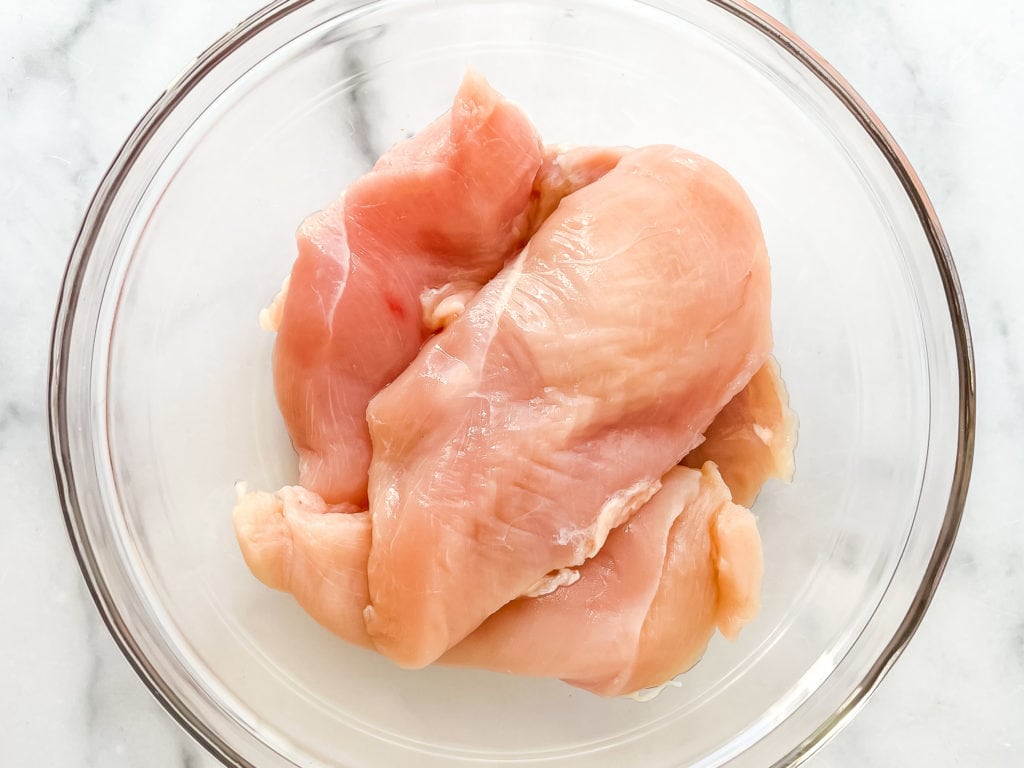What is Air-Chilled Chicken?
When it comes to buying chicken, you’ve probably noticed various labels and terms on the packaging: “organic,” “free-range,” “hormone-free,” and even “air-chilled.” So, what is air-chilled chicken, and is it better than the conventional method of chilling poultry? In this comprehensive blog post, we’ll delve deep into the world of air-chilled chicken, what it means, its benefits, drawbacks, price considerations, and whether it’s a better choice for your dinner table.

Spoiler alert, this is a splurge I often make. I find that the moisture level, flavor, and tenderness is unrivaled when it comes to grocery-store-bought meats. Yes, it costs more, but it’s WORTH IT to me!
What Is Air-Chilled Chicken?
Let’s start with the basics. Air-chilled chicken is a method of processing and cooling poultry that’s quite different from the conventional water-chilling method. In the conventional method, freshly slaughtered chickens are typically immersed in cold water to bring down their temperature rapidly. This helps meet food safety standards and prevents bacterial growth.
However, the air chilling process takes a unique approach. Instead of submerging the chicken in cold water, it’s passed through a blast of cold air to chill it down. This method avoids the use of water entirely during the chilling process, and it has gained popularity for several reasons.
What Does Air-Chilled Chicken Mean?
Air-chilled chicken gets its name from the fact that it’s cooled by circulating cold air around the birds. Here’s how the process generally works:
- Slaughter and Evisceration: After chickens are slaughtered, they go through the evisceration process, where they’re cleaned and their organs are removed.
- Cold Air Chill: Next, the chickens are hung on a processing line and passed through a blast of cold air, which rapidly reduces their temperature. This cold air can reach temperatures below freezing.
- Packaging: Once the chickens are adequately chilled, they are typically vacuum-sealed or packaged and sent for distribution.

Benefits of Air-Chilled Chicken
Now that we understand what air-chilled chicken is, let’s explore the advantages of this method compared to traditional water-chilling:
1. Better Flavor and Texture:
Air-chilled chicken enthusiasts often claim that this method results in meat with superior flavor and texture. The absence of water immersion means that the chicken retains more of its natural juices, resulting in tender and flavorful meat.
2. No Water Absorption:
Conventional water-chilled chicken can absorb water during the chilling process. While this may increase the weight of the chicken (and the price you pay), it dilutes the flavor and can lead to a less satisfying culinary experience. Air-chilled chicken avoids this issue entirely.
3. Reduced Risk of Contamination:
Water chilling can create the perfect environment for bacteria to thrive. Air-chilling reduces the risk of bacterial contamination, as the chickens are not submerged in water that can potentially harbor harmful pathogens. Ever wondered how to tell if raw chicken is bad?
4. Environmentally Friendly:
The water used in conventional chilling methods must be continually replenished and treated, making it a resource-intensive process. Air chilling is often considered more environmentally friendly because it consumes fewer resources.
5. Faster Chilling:
Air chilling is a quicker process than water chilling, which means that the chicken spends less time in the processing facility. This can lead to fresher meat and potentially improved food safety.
6. No Added Chlorine:
Some conventional methods involve adding chlorine to the water to disinfect the chickens. Air-chilled chicken doesn’t require this step, reducing the need for chemical additives.
7. Improved Skin Quality:
For those who enjoy crispy chicken skin, air-chilled chicken can be a winner. Because the skin doesn’t absorb water, it has the potential to crisp up better during cooking.

Drawbacks of Air-Chilled Chicken
While air-chilled chicken offers many benefits, it’s essential to consider potential drawbacks as well:
1. Air-Chilled Chicken Price:
One of the most significant drawbacks of air-chilled chicken is its price. The air-chilling process is more expensive than conventional water-chilling methods, which can result in a higher cost per pound of chicken.
2. Availability:
Depending on where you live, air-chilled chicken may not be as readily available as conventionally chilled chicken. Availability can vary by region and even by the grocery store you frequent.
Is Air-Chilled Chicken Better?
The question of whether air-chilled chicken is better than conventionally chilled chicken depends on your priorities and personal preferences. Let’s break it down:
When Air-Chilled Chicken Might Be a Better Choice:
- Flavor and Texture: If you prioritize taste and texture in your chicken dishes, this may be a better choice due to its ability to retain natural juices.
- Food Safety: Air chilling can reduce the risk of bacterial contamination, making it a safer option for those concerned about food-borne illnesses.
- Environmental Concerns: If you’re environmentally conscious, the reduced resource consumption of air chilling may appeal to you.
When Conventional Chicken Might Be Preferred:
- Cost: Air-chilled chicken is often pricier than conventionally chilled chicken due to the additional processing steps involved. If you’re on a tight budget, this might be a consideration.
- Availability: Depending on where you live, it may not be as readily available as conventionally chilled chicken.
- Personal Taste: Taste is subjective, and some people may not notice a significant difference between air-chilled and conventionally chilled chicken.
In the end, the “better” choice comes down to your culinary priorities and what you value in your chicken. It’s worth trying both types and deciding for yourself which one you prefer.
Price Considerations
Let’s delve deeper into the price aspect of this type of chicken. While the benefits are appealing, its higher cost can be a significant factor in the decision-making process. Here are some price-related considerations:
1. Cost per Pound:
It’s generally more expensive per pound compared to conventionally chilled chicken. The added expense can make it less budget-friendly for some consumers.
2. Budget Constraints:
If you’re on a tight budget or cooking for a large family, the cost of air-chilled chicken may not align with your financial limitations.
3. Occasional Indulgence:
Some consumers choose to reserve air-chilled chicken for special occasions or when they want to elevate a particular dish. This way, they can enjoy the benefits of air chilling without breaking the bank on a regular basis.
4. Alternatives:
For those who appreciate the benefits of air-chilling but find it cost-prohibitive, exploring other poultry options, such as buying whole chickens or cuts like thighs or drumsticks, might provide a more budget-friendly solution.
In summary, while air-chilled chicken offers several advantages, its higher price point can be a significant consideration for many consumers. It’s essential to weigh the benefits against the cost and make an informed decision based on your personal preferences and budget.
Which Type of Chicken Should You Choose?
Air-chilled chicken is a unique method of processing and chilling poultry that offers several benefits, including improved flavor, reduced risk of contamination, and environmental friendliness.
Whether it’s the right choice for you depends on your culinary preferences, priorities, and budget considerations. If you’re a discerning eater who enjoys the best possible flavor and texture in your chicken dishes, this special chicken might be worth the extra cost.
However, if budget constraints are a concern, conventionally chilled chicken can still be a delicious and satisfying option for your meals. Ultimately, the choice between air-chilled and conventional chicken is a matter of personal taste and values, and both can be part of a tasty and enjoyable dining experience.